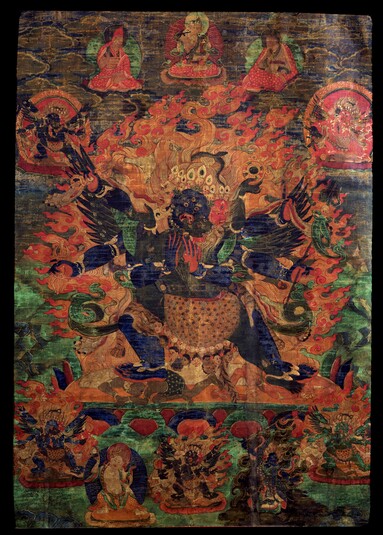
Item: Vajrakila (Eight Pronouncements)
| Origin Location | Tibet |
|---|---|
| Date Range | 1700 - 1799 |
| Lineages | Nyingma and Sakya |
| Material | Ground Mineral Pigment on Cotton |
| Collection | Tibetan Painted Scrolls |
Classification: Deity
Vajrakila, Heruka (Tibetan: dor je phur ba, thrag thung. English: Vajra Peg, Blood Drinker). The Activity Deity from the set of Eight Herukas (Tib.: ka gye) of the Mahayoga Tantras of the Nyingmapa School according to the Ancient Khon Tradition of Sakya.
Sanskrit: Vajrakila
Fearsome and wrathful, blue in colour with three faces, six hands and four legs, the right face is white and left red, each has three eyes, a gaping mouth and yellow hair flowing upward. The first pair of hands hold a kila (three sided peg) at the heart. The right hands hold a five and nine pointed vajra and the left hands hold a trident and a mass of flame. Unfurled behind are two large wings decorated with vajras. Adorned with a crown of five skulls, earrings, bracelets and a necklace of fifty heads, he wears an elephant hide across the back and a tiger skin as a lower garment. The consort Diptachakra (Flaming Wheel) is black in colour with one face and two hands holding a skullcup in the left and a gold wheel upraised in the right. Adorned with jewels, gold and a garland of fifty dry skulls she wears a leopard skin skirt and the left leg raised to embrace the male consort. Atop the splayed bodies of Maheshvara and Uma, a sun disc and multi-coloured lotus the terrific deities stand surrounded by the orange-red flames of pristine awareness.
At the top center is buddha Vajrasattva, white, with one face and two hands holding a vajra to the heart and a bell upturned at the left hip. Adorned with silks and jewels he has the peaceful appearance of Sambhogakaya - the enjoyment body of a fully enlightened buddha. At the left is the Tibetan Lu'i Wangpo Srungwa (8th century) of the Khon family lineage. A direct student of Guru Rinpoche and one of the first seven novitiate Buddhist monks of Tibet he wears monastic robes and a red pandita hat. The right hand is held in the mudra (gesture) of blessing and the left placed in the mudra of meditation in the lap. At the right is Sachen Kunga Nyingpo (1092-1158) of the Khon lineage, 3rd patriarch of the Sakya School. Wearing the garb of a layman he holds a vajra held to the heart with the right hand and a bell in the left upturned at the hip. (The hand gestures and objects are not usual for Sachen and are typically those of Jetsun Trakpa Gyaltsen - Sachen's second son).
Surrounding the central figure at the upper sides, lower sides and bottom center are the Five Herukas of the Buddha Families, Vajra, Buddha, Ratna, Padma and Karma, each in similar appearance with three faces and six hands embracing their own consort. At the bottom are the two special protectors of the Vajrakila Cycle of practice. To the left is Gauri (Tib.: kar mo), slightly wrathful, white in colour, adorned with a garland of suns and moons. With one face and two hands she holds upraised in the right the mountain sumeru, the center of each Buddhist world system, and held in the left is the circle of the four continents. To the right is Marajit (Tib.: du gyal), wrathful, blue-black in colour, with one face and two hands. The right holds aloft a lance and banner and the left a garland of bones. Attired in flowing garments he rides atop a black horse surrounded by a cloud of dark billowing smoke.
"...the king of wrath, bhagavan Vajrakumara, with a body blue-black [in colour], three faces and six hands. The right face is white, left red, the center blue. Held with the two pairs of right and left hands are a nine and five pointed vajra, a blazing mass of fire and a trident. The remaining two roll a kila. The body is huge and heavy, with bared fangs, three eyes - round and red, brown hair flowing upward; wearing an elephant hide, human skin, and a tiger skin as a lower garment. Adorned with white, red, green, and black snakes as a crown, necklace and sash, decorating the arms and legs. Five dry skulls adorn the head. Wearing a garland of fifty fresh [heads], marked with clots of rakta, spots of great ash and a smear of grease, adorned with various jewel ornaments. With four legs the right are bent and left extended atop the head of Ishvara - face down, and the breast of Uma, standing in the middle of a massive fire of pristine awareness." (Sakya Ngawang Kunga Lodro, 1729-1783).
Khon Lineage: Dharmakaya Samantabhadra, Sambhogakaya Vajrasattva, Nirmanakaya Padmasambhava, Khon Lu'i Wang Srungwa, Khon Dorje Rinchen, Khon Sherab Yontan, Khon Tsultrim Gyalpo, Khon Dorje Tsugtor, Khon Gekyab, Khon Gethong, Khon Balpo, Khon Shakya Lodro, Khon Rog Sherab Tsultrim, Khon Konchog Gyalpo, Tsechen Kunga Nyingpo, Lobpon Sonam Tsemo, Jetsun Tragpa Gyaltsen, Sapan Kunga Gyaltsen, Chogyal Pagpa Lodro Gyaltsen, etc.
Jeff Watt 12-98
Front of Painting
Wylie Transliteration of Inscription: 'Khon klu'i dbang po la na mo. Sa chen kun dga' snying po la na mo.
Publication: Tibetan Painted Scrolls
Thematic Sets
Collection of Caroline & Wesley Halpert
Tradition: Sakya Deity Paintings
Tradition: Nyingma Deity Paintings
Buddhist Deity: Vajrakila Main Page
Buddhist Protector: Gauri
Buddhist Deity: Vajrakila (Khon Tradition)

